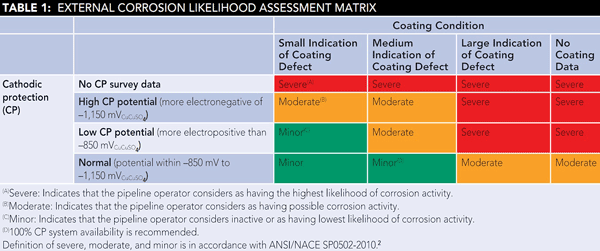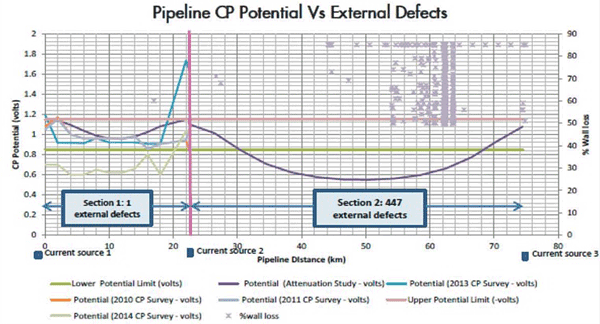As pipelines age, it is important to verify the effectiveness of the coating and cathodic protection (CP) systems that protect them against external corrosion, and implement remedial actions if necessary. To confirm a coating and CP system were still protecting a remote, aging pipeline, an external corrosion risk management assessment was carried out. The assessment included a matrix to determine the likelihood of external corrosion based on coating condition and CP survey data. The ultimate objective was to ensure the adequacy of the pipeline’s CP system.
The 74-km buried carbon steel pipeline was originally installed in 1967 and a section had been replaced in 1990. External corrosion protection consisted of a coal tar enamel coating with an impressed current CP (ICCP) system.
An external coating is the primary corrosion mitigation technique for a pipeline, and a well-applied coating can provide good corrosion protection as the pipeline ages. However, as the coating ages, it can sustain damage from natural deterioration caused by elevated temperatures, stresses, permeation, and biological influences, as well as third-party events. This creates a higher risk for external corrosion of aging pipelines compared to newer pipelines, since the coating is the primary means of corrosion protection. CP is applied to pipelines as a secondary corrosion mitigation method that will protect the pipeline in areas where the coating has defects (holidays) or damage. Coating degradation can cause the CP current requirement for aging pipelines to increase, particularly when the coating has severe damage. In cases where CP current does not provide adequate protection, the risk of external corrosion on the pipeline is even higher, and there is a possibility of a pipe failure.
Risk is generally defined in terms of the possibility or likelihood of failure and consequence of failure. Risk assessment helps to screen for risk, identify areas of potential concern, and develop a prioritized list for more in-depth inspection. Indirect evaluation methods such as CP surveys and coating surveys/condition assessments help determine the likelihood of external corrosion. However, the likelihood of external corrosion should be based on established criteria from both CP and coating rather than only one indirect assessment method, because a combination of CP and coating is used on pipelines to achieve effective external corrosion mitigation.

Historically, due to logistical issues, implementing standard inspections and other integrity assurance activities had been a challenge for the aging pipeline. To assess the likelihood of external corrosion, a simple matrix (Table 1) was developed that combined the outcomes from CP potential surveys and coating condition data. It was designed to account for instances where coating or CP survey data were not available.
The assessment included assumptions about the pipeline’s coating condition. Not only was it susceptible to third-party damage, but the coating’s age (>45 years) also affected its condition. Because coating survey data were unavailable during the pipeline assessment, the coating condition was classified as severe based on the coating survey of a similar pipeline.
Historical CP survey data—pipe-to-soil (P/S) potentials taken at test stations at intervals along a portion of the pipeline (referred to as Section 1) during five years of regular monitoring—were also reviewed. The data indicated that CP protection was adequate, with periods of overprotection and under-protection. Past CP survey data were not available for approximately two-thirds of the pipeline (referred to as Section 2) due to logistical challenges. A CP attenuation study for the entire pipeline helped to predict the behavior of CP potential for the pipeline based on coating quality.
A pipeline coating is expected to electrically insulate the pipe wall, and CP provides corrosion protection at the defects in the coating. Essentially, the current drains or attenuates at the pipe surface where coating defects occur. When only a few coating defects are present, CP current demand is lower and pipeline potential attenuation is slower. Alternatively, CP current demand is higher when more coating defects are present on the pipeline, and the pipeline potential attenuation is faster. Attenuation formulas presented in the NACE International CP-4 Cathodic Protection Specialist course1 were used to develop a CP attenuation curve for the pipeline based on the age of the pipeline coating, current sources for the existing ICCP system, and other assumptions. Since the historical CP potential survey data corroborated the prediction from the attenuation curve for Section 1, the surveyed portion of the pipeline, the attenuation curve was relied on to predict the CP current attenuation for Section 2 of the pipeline that did not have historical CP potential survey data.

The results of the historical CP potential surveys and the attenuation curve for the entire length of the pipeline were plotted. Using the external corrosion risk assessment matrix in Table 1, a significant portion of Section 2 of the pipeline was determined to be at severe risk of external corrosion. To verify the external corrosion risk identified in the assessment, inline inspection (ILI) was used to collect and record information about the pipeline, such as the size, location, and orientation of wall loss (both internal and external) along the entire length of the pipeline. The ILI indicated one significant corrosion defect in Section 1 of the pipeline, and 447 significant corrosion defects in Section 2. The external corrosion defect data from the ILI was combined with the CP potential survey data and the attenuation curve so the direct impact of CP on the corrosion defects along the pipeline could be evaluated (Figure 1). The ILI results corroborated the expectations, indicated by the potential surveys and the attenuation curves, that a portion of Section 2 was experiencing corrosion from inadequate CP. The external corrosion risk assessment and ILI verification justified the need to retrofit the CP system.
To mitigate the corrosion of Section 2, the decision was made to augment the existing ICCP system with magnesium sacrificial anodes as an immediate response while other integrity-related remedial actions were planned to be implemented. CP design calculations indicated that 144 15-kg sacrificial anodes were required to ensure adequate CP on Section 2. Initially, 100 anodes were installed near areas of Section 2 where wall loss was most concentrated, and the remaining 44 anodes were then installed so that Section 2 was fully covered. A subsequent CP survey of the pipeline indicated that the installation of the sacrificial anodes polarized the pipeline to the correct P/S potential so external corrosion growth is minimized and risk is reduced.
This case study3 was presented at the 2016 NACE Corrosion Risk Management Conference. Special thanks to Bademosi Adebayo for his support toward completing this study.
Contacts: Samuel Ojo, Jerry Anietie, Humphrey Ezeifedi, and Mercy Aguye, Shell Petroleum Development Co. of Nigeria—e-mail: samuel.ojo@shell.com.
References
1 NACE CP-4, Cathodic Protection Specialist Course Manual (Houston, TX: NACE International).
2 ANSI/NACE SP0502-2010, “Pipeline External Corrosion Direct Assessment Methodology” (Houston, TX: NACE, 2010).
3 S. Ojo, M. Aguye, H. Ezeifedi, J. Anietie, “Retrofitting the Cathodic Protection System of an Ageing Pipeline,” Corrosion Risk Management Conference, paper no. RISK16-8740 (Houston, TX: NACE, 2016).